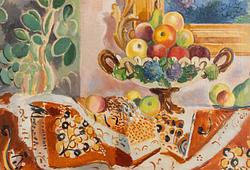Lucio Fontana, "Concetto Spaziale, Attese" at Modern Art + Design
Concetto Spaziale, Attese is one of a series of works Fontana made in Milan between 1958 and 1968 that are collectively known as Tagli (‘cuts’). Together they constitute Fontana’s largest and most varied series of iconic works and have come to epitomise the artist’s expressive creativity.
Up until the 1940s Fontana lived and worked in Italy and France, but at the start of the Second World War he travelled to Argentina. It was in Buenos Aires at the Academia de Altamira that his ideas of ‘Spazialismo’ were born, the artistic movement that Fontana founded and which came to shape his entire artistic career. In his manifesto from 1946, Manifesto Blanco, he encouraged artists and like-minded to abandon traditional and academic notions of art to embrace new technologies and science in order to create a fourth dimension.
A significant aspect to what made him so compelling was his ability to merge sculpture and painting.
His choice of forms remained inconsistent throughout his career – from geometrical perfection to shapes that were more difficult to define. It wasn’t about the cuts or the holes in themselves, but about the process of getting there. Fontana’s work was a product of its time, independently of his choice of medium or technique.
Fontana had already begun to work with the concept ‘Concetto Spaziale’ in 1947. A few years later he created the series Pietre (‘stones’) where he fused painting and sculpture by applying thick layers of paint on the canvas and then adding a collage of coloured pieces of glass. Shortly thereafter followed a series of works he called Buchi (‘holes’). Here the canvas was punctured and perforated with holes in order to break up its two-dimensional quality and expose the space behind the painting. It was towards the end of the 1950s that he began making the Tagli pieces, that, together with the Buchi, became the forms he continued to work with until his death in 1968. Through his ‘Concetto Spaziale’ Fontana succeeded in erasing the border between painting and sculpture.
The first Tagli were executed in the late summer and autumn of 1958 when Fontana was almost 60 years old.
The canvases were filled with small diagonal cuts in formations. Fontana experimented with both the size and the shape of the Tagli. As time passed the cuts became fewer but more forceful. In order to achieve the right effect the artist was particularly careful with the surface of the canvas, first ‘purifying’ it with a matt, often water-based, monochrome colour. The pieces with only one cut are marked Attesa whilst the canvases with multiple cuts are marked in the plural Attese, translated as ‘hopes’ or ‘aspirations’, a meaning that gives the pieces an additional conceptual dimension. Fontana dressed the back of the canvas with ‘telleta’, strips of black gauze, in order to create the illusion of space and void beyond the cut. In Tagli destruction and creation became one. Each cut in the canvas is executed in a single decisive and irrevocable movement. The physical act that forcefully ruptures the canvas simultaneously opens up a new sculptural and spatial perspective of the dark infinity beyond the surface of the canvas.
Fontana’s artistic journey with Tagli and Buchi coincided with the Space Race of the 1960s. The ultimate destination for man’s travel into cosmos was the Moon, and in 1961 Yuri Gagarin became the first man in space.
“As a painter, while working on one of my perforated canvases, I do not want to make a painting; I want to open up space, create a new dimension for art, tie in at the cosmos as it endlessly expands beyond the confining plane of the picture. With my innovation of the hole pierced through the canvas in repetitive formations, I have not attempted to decorate a surface, but, on the contrary, I have tried to break its dimensional limitations. Beyond the perforations a newly gained freedom of interpretation awaits us, but also, and just as inevitably, the end of art”. (Lucio Fontana, 1966)
Alberto Burri och Lucio Fontana, c. 1965. Ph. Giuseppe Loy, Roma.
Photo: Courtesy Fondazione Lucio Fontana, Milan
Lucio Fontana, "Concetto Spaziale, Attese"
Modern Art + Design 27 November



























